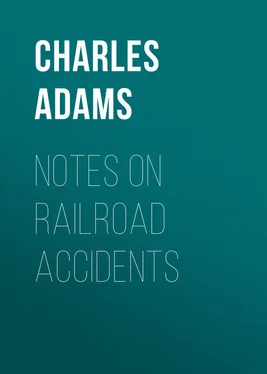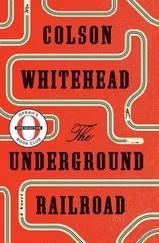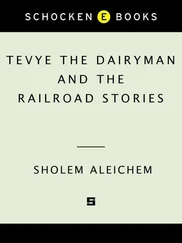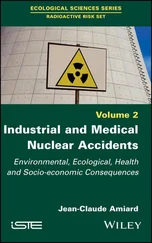Charles Adams - Notes on Railroad Accidents
Здесь есть возможность читать онлайн «Charles Adams - Notes on Railroad Accidents» — ознакомительный отрывок электронной книги совершенно бесплатно, а после прочтения отрывка купить полную версию. В некоторых случаях можно слушать аудио, скачать через торрент в формате fb2 и присутствует краткое содержание. Жанр: foreign_antique, foreign_prose, на английском языке. Описание произведения, (предисловие) а так же отзывы посетителей доступны на портале библиотеки ЛибКат.
- Название:Notes on Railroad Accidents
- Автор:
- Жанр:
- Год:неизвестен
- ISBN:нет данных
- Рейтинг книги:4 / 5. Голосов: 1
-
Избранное:Добавить в избранное
- Отзывы:
-
Ваша оценка:
- 80
- 1
- 2
- 3
- 4
- 5
Notes on Railroad Accidents: краткое содержание, описание и аннотация
Предлагаем к чтению аннотацию, описание, краткое содержание или предисловие (зависит от того, что написал сам автор книги «Notes on Railroad Accidents»). Если вы не нашли необходимую информацию о книге — напишите в комментариях, мы постараемся отыскать её.
Notes on Railroad Accidents — читать онлайн ознакомительный отрывок
Ниже представлен текст книги, разбитый по страницам. Система сохранения места последней прочитанной страницы, позволяет с удобством читать онлайн бесплатно книгу «Notes on Railroad Accidents», без необходимости каждый раз заново искать на чём Вы остановились. Поставьте закладку, и сможете в любой момент перейти на страницу, на которой закончили чтение.
Интервал:
Закладка:
Those cars were of the most approved form of American construction, but here, as at Shipton, the violent application of the train-brakes and reversal of the locomotives had greatly checked the speed of the forward part of the train, while the whole rear of it, comparatively free from brake pressure, was crowding heavily forward. Including its living freight, the entire weight of the train could not have been less than 500 tons. There was no slack between its parts; no opportunity to give. It was a simple question of the resisting power of car construction. Had the train consisted of ten cars instead of twenty-two a recent experience of a not dissimilar accident on this very road affords sufficient evidence of how different the result would have been. On the occasion referred to, – October 13, 1876, – a train consisting of two locomotives and fourteen cars, while rounding a curve before the Randolph station at a speed of thirty miles an hour came in sudden collision with the locomotive of a freight train which was occupying the track, and while doing so, in that case also as at Wollaston, had wholly neglected to protect it. So short was the notice of danger that the speed of the passenger train could not at the moment of collision have been less than twenty miles an hour. The freight train was at the moment fortunately backing, but none the less it was an impassable obstacle. The three locomotives were entirely thrown from the track and more or less broken up, and three cars of the passenger train followed them, but the rest of it remained in line and on the rails, and was so entirely uninjured that it was not found necessary to withdraw one of the cars from service for even a single trip. Not a passenger was hurt. This train consisted of fourteen cars: but at Wollaston, the fourteen forward cars were, after the head of the train was derailed, driven onward not only by their own momentum but also by the almost unchecked momentum of eight other cars behind them. The rear of the train did not leave the rails and was freely moving along them. By itself it must have weighed over 200 tons. The result was inevitable. Something had to yield; and the six forward cars were accordingly either thrown wholly to the one side or the other, or crushed between the two locomotives and the rear of the train. Two of them in fact were reduced into a mere mass of fragments. The disaster resulted in the death of 19 persons, while a much greater number were injured, more than 50 seriously. In this as in most other railroad disasters the surprising thing was that the list of casualties was not larger. Looking at the position of the two cars crushed into fragments it seemed almost impossible that any person in them could have escaped alive. Indeed that they did so was largely due to the fact that the season for car-warming had not yet arrived, while, in some way impossible to explain, all four of the men in charge of the locomotives, though flung violently through the air into the trees and ditch at the side of the road were neither stunned nor seriously injured. They were consequently able, as soon as they could gather themselves up, to take the measures necessary to extinguish the fires in their locomotives which otherwise would speedly have spread to the débris of the train. Had they not done so nothing could have saved the large number of passengers confined in the shattered cars.
CHAPTER IV.
ACCIDENTS AND CONSERVATISM
The four accidents which have been referred to, including that of April 17, 1836, upon the Manchester & Liverpool road, belong to one class. Though they covered a period of forty-two years they were all due to the same cause, the sudden derailment of a portion of the train, and its subsequent destruction because of the insufficient control of those in charge of it over its momentum. In the three earlier cases the appliances in use were much the same, for between 1836 and 1874 hardly any improvement as respects brakes had either forced its own way, or been forced by the government, into general acceptance in Great Britain. The Wollaston disaster, on the other hand, revealed a weak point in an improved appliance; the old danger seemed, indeed, to take a sort of pleasure in baffling human ingenuity. The Shipton accident, however, while one of the most fatal which ever occurred was also one of the most fruitful in results. This, and the accident of April 17, 1836, upon the Manchester & Liverpool road were almost precisely similar, though no less than thirty-eight years intervened between them. In the case of the first, however, no one was killed and consequently it was wholly barren of results; for experience has shown that to bring about any considerable reform, railroad disasters have, as it were, to be emphasized by loss of life. This, however, implies nothing more than the assertion that those responsible for the management of railroads do not differ from other men, – that they are apt, after some hair-breadth escape, to bless their fortunate stars for the present good rather than to take anxious heed for future dangers.
At the time the Shipton accident occurred the success of the modern train-brake, which places the speed of each of the component parts of the train under the direct and instantaneous control of him who is in charge of the locomotive, had for years been conceded even by the least progressive of American railroad managers. The want of such a brake and the absence of proper means of communication between the parts of the train had directly and obviously caused the murderous destructiveness of the accident. Yet in the investigation which ensued it appeared that the authorities of the Great Western Railway, being eminently "practical men," still entertained as respected the train-brake "very grave doubts of the wisdom of adopting [it] at all;" while at the same time, as respected a means of communication between the parts of the train, it appeared that the associated general managers of the leading railways "did not think that any [such] means of communication was at all required, or likely to be useful or successful."
Though quite incomprehensible, there is at the same time something superb in such an exhibition of stolid conservatism. It is British. It is, however, open to but one description of argument, the ultima ratio of railroad logic. So long as luck averted the loss of life in railroad disasters, no occasion would ever have been seen for disturbing time-honored precautions or antiquated appliances. While, how ever, a disaster like that of December 24, 1874, might not convince, it did compel: in spite of professed "grave doubts," incredulity and conservatism vanished, silenced, at least, in presence of so frightful a row of corpses as on that morning made ghastly the banks of the Cherwell. The general, though painfully slow and reluctant, introduction of train-brakes upon the railways of Great Britain may be said to have dated from that event.
In the matter of communication between those in the train and those in charge of it, the Shipton corpses chanced not to be witnesses to the precise point. Accordingly their evidence was, so to speak, ruled out of the case, and neither the utility nor the success of any appliance for this purpose was held to be yet proven. What further proof would be deemed conclusive did not appear, but the history of the discussion before and since is not without value. There is, indeed, something almost ludicrously characteristic in the manner with which those interested in the railway management of Great Britain strain at their gnats while they swallow their camels. They have grappled with the great question of city travel with a superb financial and engineering sagacity, which has left all other communities hopelessly distanced; but, while carrying their passengers under and over the ebb and flow of the Thames and among the chimney pots of densest London to leave them on the very steps of the Royal Exchange, they have never been able to devise any satisfactory means for putting the traveller, in case of a disaster to the carriage in which he happens to be, in communication with the engine-driver of his train. An English substitute for the American bell-cord has for more than thirty years set the ingenuity of Great Britain at defiance.
Читать дальшеИнтервал:
Закладка:
Похожие книги на «Notes on Railroad Accidents»
Представляем Вашему вниманию похожие книги на «Notes on Railroad Accidents» списком для выбора. Мы отобрали схожую по названию и смыслу литературу в надежде предоставить читателям больше вариантов отыскать новые, интересные, ещё непрочитанные произведения.
Обсуждение, отзывы о книге «Notes on Railroad Accidents» и просто собственные мнения читателей. Оставьте ваши комментарии, напишите, что Вы думаете о произведении, его смысле или главных героях. Укажите что конкретно понравилось, а что нет, и почему Вы так считаете.












